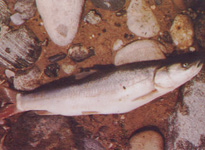Its Latin name is Aspiorhynchus laticeps. Also known as big-headed carp, tiger fish, naked-snout carp andNanjiangbig-headed carp, it is a member of the Cyprinidaefamily of theCyprinformes order. As a specific fish species native to China and rare species of Schizothorax,Tarim Bighead-highland Carpis endowed with high economic value and academic value.
 |
|
It has a long body, flat flank, round belly, big head, flat snout, wide and big mouth with oblique segmentation. Its lower jaw is longer than the upper jaw. There is a pair of stubbles on the corners of mouth, and there are 3 rows of slender prismatic hypopharynx teeth with uncuses on the tips. Scales on the back are small while those on both sides are relatively bigger. There is a row of outsize anal fins respectively on both sides of anus base, with developed anal scales. It has a large physique with a body length of 90 centimeters and a weight of 14 kilograms or more. As a member of fishes dwelling at water bottom, it moves around in slack water of rivers and still water of lakes. It is a ferocious animal, feeding on other fishes. Its spawning season is short, chiefly from late April to mid-May.
It is widely distributed in Kaidu River, Aksu River, Che'erchen River and Ye'erqiang River, which are in the water system of Talimu River of Xinjiang Uygur Autonomus Region, China's northwest area. Reputed for its large body conformation, delicious taste and high economic value, it was once the major object of Xinjiang's fishery in the early stage of the new China, with an annual production up to 240 tons. As a result of long-term excessive fishing, the species was on the brink of extinction by the 1980s. Scientific research and artificial propagation have been carried out on the basis of summing up experiences and lessons. Meanwhile, with the enhanced promotion ofThe Law for Wildlife Protection, self-awareness among people to protect this precious wild animal resource has been greatly enhanced.
